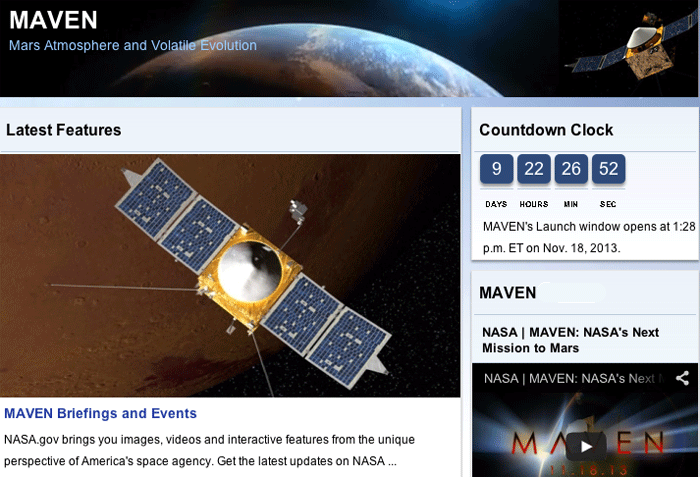.
10.02.2013

.
NASA’s Mars Atmosphere and Volatile EvolutioN (MAVEN) spacecraft is assembled and is undergoing environmental testing at Lockheed Martin Space Systems facilities, near Denver, Colo. MAVEN is the next mission to Mars and will be the first mission devoted to understanding the Martian upper atmosphere.
During the environmental testing phase, the orbiter will undergo a variety of rigorous tests that simulate the extreme temperatures, vacuum and vibration the spacecraft will experience during the course of its mission. Currently, the spacecraft is in the company’s Reverberant Acoustic Laboratory being prepared to undergo acoustics testing that simulates the maximum sound and vibration levels the spacecraft will experience during launch.
Following the acoustics test, MAVEN will be subjected to a barrage of additional tests, including: separation/deployment shock, vibration, electromagnetic interference/electromagnetic compatibility and magnetics testing. The phase concludes with a thermal vacuum test where the spacecraft and its instruments are exposed to the vacuum and extreme hot and cold temperatures it will face in space.
“The assembly and integration of MAVEN has gone very smoothly and we’re excited to test our work over the next six months,” said Guy Beutelschies, MAVEN program manager at Lockheed Martin Space Systems Company. “Environmental testing is a crucial set of activities designed to ensure the spacecraft can operate in the extreme conditions of space.”
“I’m very pleased with how our team has designed and built the spacecraft and science instruments that will make our measurements,” said Bruce Jakosky, MAVEN principal investigator from CU/LASP. “We’ve got an exciting science mission planned, and the environmental testing now is what will ensure that we are ready for launch and for the mission.”
MAVEN is scheduled to ship from Lockheed Martin’s facility to NASA’s Kennedy Space Center in early August where it will undergo final preparations for launch.
MAVEN, scheduled to launch in November 2013, is a robotic exploration mission to understand the role that loss of atmospheric gas to space played in changing the Martian climate through time. It will investigate how much of the Martian atmosphere has been lost over time by measuring the current rate of escape to space and gathering enough information about the relevant processes to extrapolate backward in time.
“This phase of the program is particularly important in that it will provide us with a good assessment of the MAVEN system’s capabilities under the simulated extremes of the space environment,” said David Mitchell, MAVEN project manager at NASA’s Goddard Space Flight Center in Greenbelt, Md. “Of significance, the spacecraft is entering system level test right on schedule, while maintaining robust cost and schedule reserves to deal with the technical or programmatic surprises that could occur during test or in the run to launch. Tracking on plan is critically important to being ready for launch later this year and the science that MAVEN will deliver one year later.”
MAVEN’s principal investigator is based at the University of Colorado at Boulder’s Laboratory for Atmospheric and Space Physics. The university will provide science operations, science instruments and lead Education/Public Outreach. NASA’s Goddard Space Flight Center manages the project and provides two of the science instruments for the mission. Lockheed Martin of Littleton, Colo., built the spacecraft and is responsible for mission operations. The University of California at Berkeley Space Sciences Laboratory provides science instruments for the mission. NASA’s Jet Propulsion Laboratory, Pasadena, Calif., provides navigation support, the Deep Space Network and the Electra telecommunications relay hardware and operations.
.

NASA’s MAVEN spacecraft recently completed assembly and has started environmental testing. In the Multipurpose Test Facility clean room at Lockheed Martin, technicians installed the orbiter’s two solar arrays prior to a modal test. (Courtesy Lockheed Martin)
.
Quelle: NASA
.
Update: 17.07.2013
.
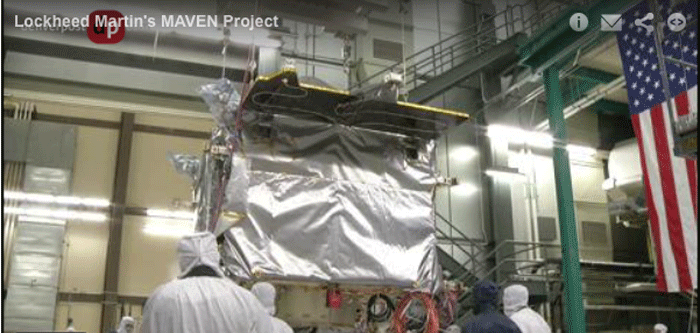
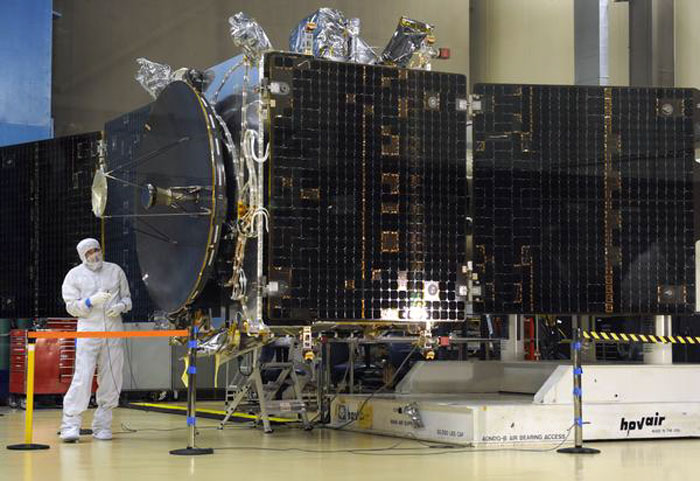
DENVER - The Mars Atmosphere and Volatile Evolution spacecraft is now in Cape Canaveral.
MAVEN will be hurled toward Mars in November on a mission largely designed and constructed in Colorado. The project is NASA's first mission to Mars since Curiosity Rover a year ago.
MAVEN is not a lander. It's an orbiter, and its first mission is devoted to understanding the Martian upper atmosphere. The ultimate goal is to determine the impact that the loss of atmosphere had on climate change.
Some of the engineers have been working on this project for more than a decade.
The estimated cost is $453 million - about $300 million has flowed directly into Colorado.
Timing is critical, however. The launch window opens on Nov. 18 and lasts for about 20 days.
The University of Colorado-Boulder has played a part of this project also. Its labs will serve as the hub for all science operations on MAVEN.
Lockheed Martin will man the spacecraft while it's still flying. As many as 210 people worked on this project at Lockheed Martin.
Colorado has the nation's second-largest aerospace economy. There are more than 200 space-related companies that call the state home. More than 166,000 people are employed in space-related jobs.

Quelle: NBC
.
MAVEN makes its last stop before Mars
Orbiter arrives at KSC; November launch planned
.
A NASA spacecraft has reached its last stop before embarking on a 10-month journey to Mars, arriving Friday at Kennedy Space Center to prepare for a planned November blastoff.An Air Force C-17 cargo plane delivered the MAVEN orbiter from Colorado to the former shuttle runway around 8 p.m.
MAVEN is short for “Mars Atmosphere and Volatile Evolution.”
The $671 million mission, carrying three suites of instruments, will spend at least a year studying the Red Planet’s upper atmosphere and climate history.
Scientists hope to learn more about why most of Mars’ once thicker, warmer atmosphere was lost, changing a more habitable climate to its current cold, dry state.
After its delivery here, the Lockheed Martin Corp.-built orbiter was headed to KSC’s Payloads Hazardous Servicing Facility for pre-launch testing.
The spacecraft is expected to move to a Cape Canaveral launch pad in early November to be hoisted atop a United Launch Alliance Atlas V rocket.
The launch must hit a 20-day window between Nov. 18 and Dec. 7, or else wait two years for the proper planetary alignment to return.
NASA says the mission is on track to launch Nov. 18 and begin orbiting Mars in September 2014.
NASA on Tuesday will celebrate the anniversary of its Curiosity rover touching down on the Martian surface.
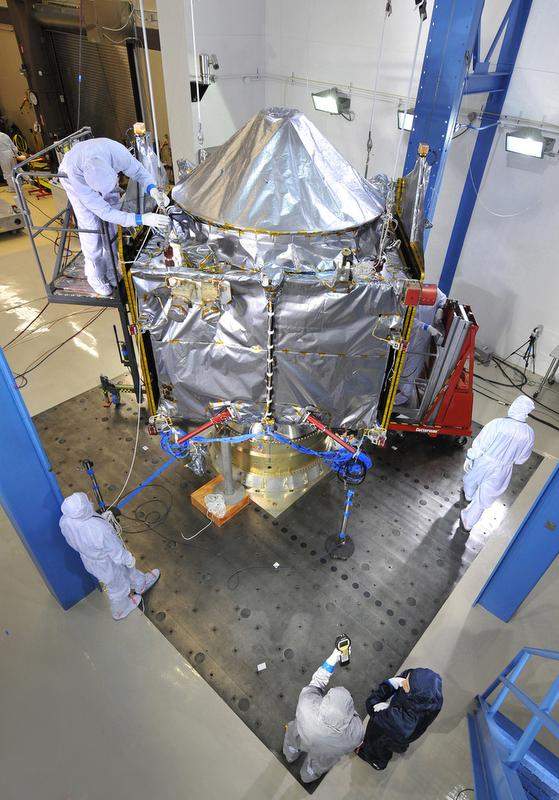
NASA's MAVEN underwent acoustics testing in February at Lockheed Martin Space Systems' Reverberant Acoustic Laboratory. MAVEN is the first spacecraft devoted to understanding the Martian upper atmosphere. / Lockheed Martin Corp.
.
NASA’s Mars Atmosphere and Volatiles Evolution (MAVEN) spacecraft is seen inside the Payload Hazardous Servicing Facility on Aug. 3. 2013 at the agency’s Kennedy Space Center in Florida. MAVEN will be prepared inside the facility for its scheduled November launch to Mars.
NASA's next spacecraft going to Mars arrived Friday, Aug. 2, at the agency's Kennedy Space Center in Florida, and is now perched in a cleanroom to begin final preparations for its November launch.
The Mars Atmosphere and Volatile Evolution (MAVEN) spacecraft is undergoing detailed testing and fueling prior to being moved to its launch pad. The mission has a 20-day launch period that opens Nov. 18.
The spacecraft will conduct the first mission dedicated to surveying the upper atmosphere of Mars. Scientists expect to obtain unprecedented data that will help them understand how the loss of atmospheric gas to space may have played a part in changing the planet's climate.
"We're excited and proud to ship the spacecraft right on schedule," said David Mitchell, MAVEN project manager at NASA's Goddard Space Flight Center in Greenbelt, Md. "But more critical milestones lie ahead before we accomplish our mission of collecting science data from Mars. I firmly believe the team is up to the task. Now we begin the final push to launch."
Over the weekend, the team confirmed the spacecraft arrived in good condition. They removed the spacecraft from the shipping container and secured it to a rotation fixture in the cleanroom. In the next week, the team will reassemble components previously removed for transport. Further checks prior to launch will include software tests, spin balance tests, and test deployments of the spacecraft's solar panels and booms.
The spacecraft was transported from Buckley Air Force Base in Aurora, Colo., on Friday, aboard a U.S. Air Force C-17 cargo plane. Lockheed Martin Space Systems in Littleton, Colo., designed and built the spacecraft and is responsible for testing, launch processing, and mission operations.
"It's always a mix of excitement and stress when you ship a spacecraft down to the launch site," said Guy Beutelschies, MAVEN program manager at Lockheed Martin. "It's similar to moving your children to college after high school graduation. You're proud of the hard work to get to this point, but you know they still need some help before they're ready to be on their own."
Previous Mars missions detected energetic solar fields and particles that could drive atmospheric gases away from Mars. Unlike Earth, Mars does not have a planet-wide magnetic field that would deflect these solar winds. As a result, these winds may have stripped away much of Mars' atmosphere.
MAVEN's data will help scientists reconstruct the planet's past climate. Scientists will use MAVEN data to project how Mars became the cold, dusty desert planet we see today. The planned one-year mission begins with the spacecraft entering the Red Planet's orbit in September 2014.
"MAVEN is not going to detect life," said Bruce Jakosky, planetary scientist at the University of Colorado Boulder and MAVEN's principal investigator. "But it will help us understand the climate history, which is the history of its habitability."
MAVEN's principal investigator is based at the University of Colorado Laboratory for Atmospheric and Space Physics in Boulder. The university provides science instruments and leads science operations, education and public outreach.
Goddard manages the project and provides two of the science instruments for the mission. Lockheed Martin built the spacecraft and is responsible for mission operations. The University of California at Berkeley's Space Sciences Laboratory provides science instruments for the mission. NASA's Jet Propulsion Laboratory in Pasadena, Calif., provides navigation support, Deep Space Network support, and Electra telecommunications relay hardware and operations.
Quelle: NASA
.
Update: 27.08.2013
.
Rocket for MAVEN Mars mission arrives at Cape

The Atlas V rocket booster and Centaur upper stage will launch NASA's next Mars orbiter in November. The components arrived at Cape Canaveral on Monday, August 26, 2013.
.

.
The Atlas V booster and Centaur upper stage that will launch NASA's next Mars orbiter rolled off a ship this morning at a Cape Canaveral Air Force Station wharf.
The roughly 19-story rocket, when fully fully assembled, is scheduled to launch the Mars Atmosphere and Volatile EvolutioN mission, or MAVEN, on Nov. 18.
That's the opening of an official 20-day launch window, but mission managers say they have another 15 days available if needed.
The MAVEN spacecraft is undergoing preflight tests at Kennedy Space Center.
The rocket was delivered from Decatur, Ala., aboard United Launch Alliance's Mariner ship.
.
Update: 18.09.2013
.
Mars-Sonde MAVEN wird von NASA der Presse am 27.September 2013 vorgestellt.





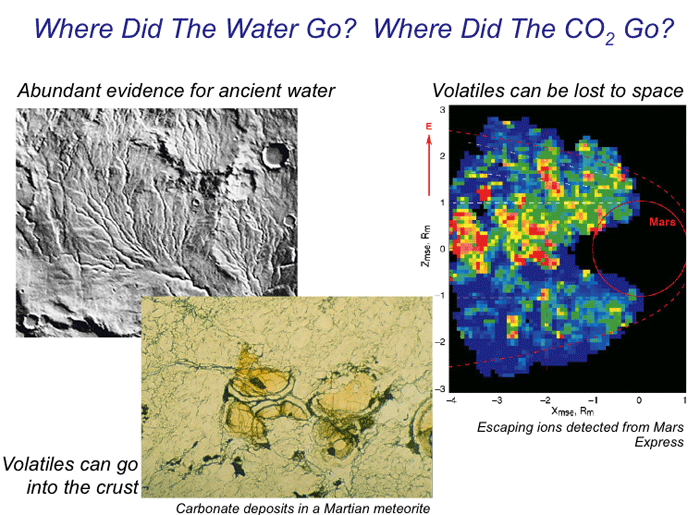










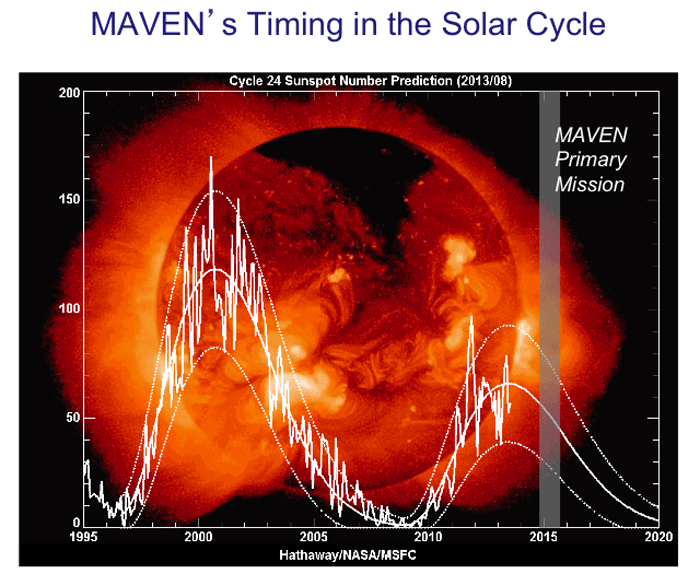



Working from their consoles at NASA's Kennedy Space Center, a team of test engineers from the Jet Propulsion Laboratory in California, better known as JPL, conducted more than a week of evaluations on the antennas and circuitry aboard the spacecraft.
They beamed signals to the low-gain and high-gain antennas on MAVEN and basically treated the machine as though it really were flying on a 10-month journey from Earth to Mars and then studying the upper atmosphere of the Red Planet.
Such work is critical, mission managers said, because there is no way to fix a spacecraft's communications system once it leaves Earth.
"It doesn't matter what we do out there if we can't get the data back to Earth," said Jeff Coyne, Lockheed Martin's Assembly Test and Launch Operations manager for the project.
MAVEN is short for Mars Atmosphere and Volatile Evolution. It is scheduled to launch in November aboard a United Launch Alliance Atlas V.
"I say this is one of the most important things, because if we can't talk to it . . . ," said Sheryl Bergstrom, manager of JPL's Cape Operations Office at Kennedy.
The testing was standard stuff for the engineers, but nonetheless mind-bending considering that the spacecraft will operate millions of miles from Earth and rely on commands from operators at Goddard Space Flight Center in Maryland.
To mimic the distances between the spacecraft and Earth, the electronic signals sent between the two during testing are run through a cabling system that quickly ramps down the power by going through various wiring networks.
"We'll try to squeeze the signal down to its lowest possible point," said Chris Green, an engineer with Exelis who supervised the testing. "It's a machine and we test its actual flight performance -- every scenario of flight configuration it would be in is what we go through in testing."
"We allow the project to get online and do what they would do on a normal day so they can perform all the tasks through us just as if MAVEN was actually in space," said Lorenzo Morgan, one of the engineers operating and evaluating the procedures.
Although every spacecraft goes through intense communications testing, the work is not considered routine because every spacecraft has unique requirements.
"Every mission is different, every mission has its own peculiarities," said Albert Ibarra, also a test engineer for the communications system. "You have to know the details on every spacecraft design and so you become familiar with it as soon as they start putting the spacecraft together."
NASA has an intricate system of antennas in California, Spain and Australia to pick up and transmit signals to its fleet of spacecraft that now reaches out beyond the solar system in the form of Voyager 1.
Called the Deep Space Network and referred to by its acronym, DSN, the system uses antennas almost as big as a football field to communicate with the spacecraft that are using their own much smaller antennas and more limited power sources.
It's the system NASA uses to communicate with all of its interplanetary probes and some of the spacecraft studying Earth, as well. In addition to Voyager 1, whose signal is incredibly weak because of the vast distance it is from Earth, the network is picking up signals from newer spacecraft such as New Horizons, which is speeding toward Pluto. Cassini in orbit around Saturn, Juno on its way to Jupiter and the Curiosity rover operating on Mars all relay their data to Earth on the DSN and get their commands from ground operators through the same network.
Kennedy's portion of the DSN structure is a testing facility called MIL-71, a reference to the time when the space center was known as the Merritt Island Launch Annex. Every time a spacecraft comes to Kennedy for launch preparations, a team of engineers sets up racks of equipment and computer servers before beginning several days of 12-hour shifts to make sure the mission's communications system and interface with the Deep Space Network will work.
With the spacecraft checked out, the team takes its gear back to California and gets ready for launch day, knowing very well that it won't hear anything from the spacecraft until well after liftoff. In the case of MAVEN, the engineers and scientists won't find out if the testing really was successful until 54 minutes after launch from Cape Canaveral when MAVEN makes its initial contact with the DSN.
"When the signal is acquired," said Bergstrom, a veteran of long wait-times for good missions and bad, "that's when we get to breathe."
Quelle: NASA
NASA offers look at Mars orbiter MAVEN targeting Nov. 18 launch
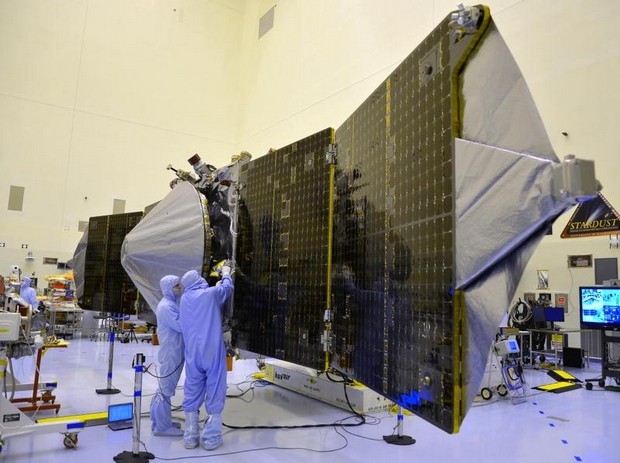

"It’s going to tell us why the atmosphere changed over time," said Bruce Janofsky, the mission’s lead scientist from the University of Colorado’s Laboratory for Atmospheric and Space Physics. "We think that the surface was conducive to supporting life four billion years ago, and not today, and we’re trying to learn why."
The spacecraft is undergoing pre-launch tests and preparations at Kennedy Space Center before moving to the Cape in early November for attachment to a United Launch Alliance Atlas V rocket.
The launch is targeted for Nov. 18, the opening of a 20-day window, to start a 10-month journey to Mars.
"These are exciting times," said Dave Mitchell, NASA project manager from the Goddard Space Flight Center in Greenbelt, Md. "We’ve been working on this mission for years, and we’re close now, real close, and we’re going to Mars, so it’s really pretty cool to be at this point."
NASA today invited members of the media to don light blue bunny suits and enter an ultra-clean Kennedy high bay where Maven sat in an orange glow with two black solar array wings spread out.
From tip to tip, the spacecraft measured about the length of a school bus.
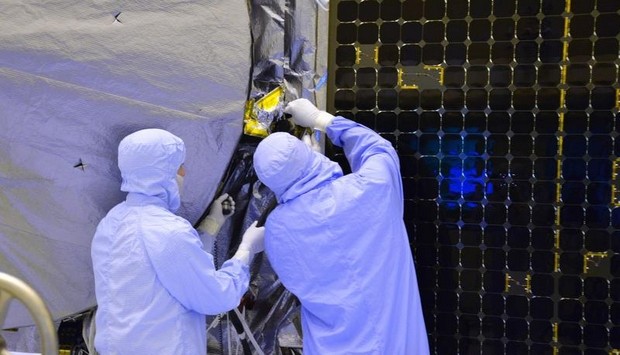
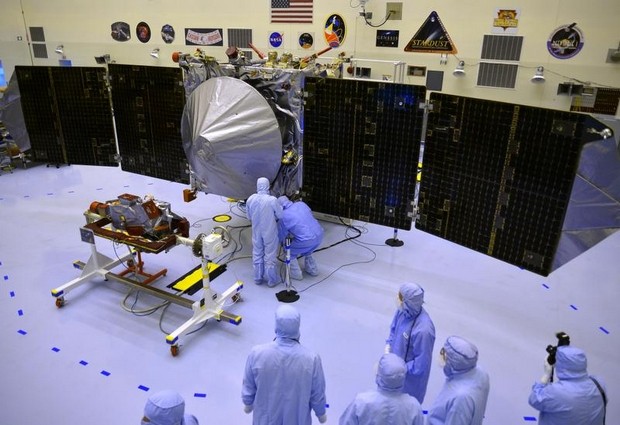
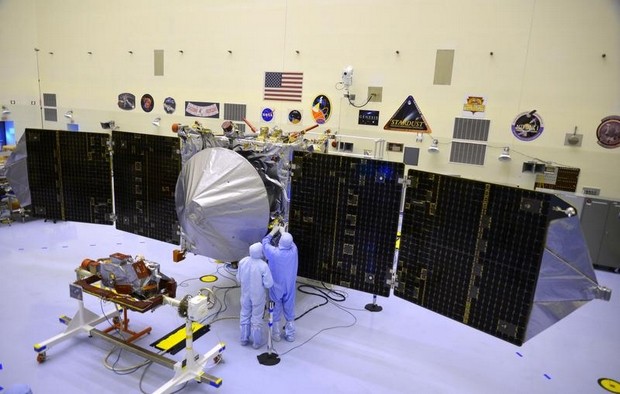
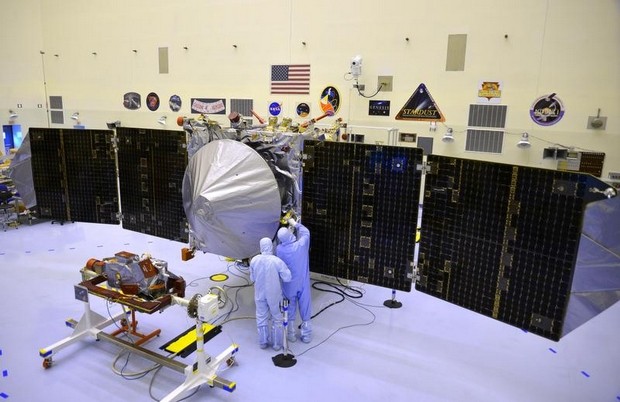



Launch preparations will resume
In an increasingly rare display of sanity from Washington, NASA's Mars Atmosphere and Volatile Evolution Mission (MAVEN) was declared "excepted" from the current government shutdown so preparations for its November launch could continue.
Bruce Jakosky, the Principal Investigator for the MAVEN mission, shared the news:
I learned this morning that NASA has analyzed the MAVEN mission relative to the Anti-Deficiency Act and determined that it meets the requirements allowing an emergency exception.
MAVEN is required as a communications relay in order to be assured of continued communications with the Curiosity and Opportunity rovers. The rovers are presently supported by Mars Odyssey launched in 2001 and Mars Reconnaissance Orbiter launched in 2005. Launching MAVEN in 2013 protects the existing assets that are at Mars today.
A delay in the launch date by more than a week past the end of the nominal launch period, or a delay of launch to 2016, would require additional fuel to get into orbit. This would have precluded having sufficient fuel for MAVEN to carry out its science mission and to operate as a relay for any significant time. Our nominal launch period runs from 18 November through 7 December, and we can launch as late as about 15 December without a significant impact on our combined science and relay activities. There is no NASA relay orbiter planned post-MAVEN.
Although the exception for MAVEN is not being done for science reasons, the science of MAVEN clearly will benefit from this action. Launching in 2013 allows us to observe at a good time in the eleven-year solar cycle.
We have already restarted spacecraft processing at Kennedy Space Center, working toward being ready to launch on Nov. 18. We will continue to work over the next couple of days to identify any changes in our schedule or plans that are necessary to stay on track.
As reported earlier, the MAVEN spacecraft is in its final stages of assembly and testing at the Kennedy Space Center in Cape Canaveral, Florida. While the team had a few days of buffer built in to the schedule, an extended shutdown of activity would have delayed MAVEN's launch, potentially past the tight, three-week opportunity that comes around every 26 months.
MAVEN with solar panels open in the clean room for the last time
NASA / Kim Shiflett
MAVEN with solar panels open in the clean room for the last time
On September 27, 2013, members of the media were given a final opportunity to view the MAVEN Mars orbiter before it was prepared for launch.
Missing the launch opportunity would cost NASA hundreds of millions of dollars to store both the spacecraft and the Atlas V rocket for the next two years.
From an interview with Universe Today, mission PI Bruce Jakosky emphasized their determination to get MAVEN to Mars on time:
[Jakosky] said the team will do whatever necessary, including overtime, to launch MAVEN to the Red Planet by Dec. 7.
"The team is committed to getting to the launch pad at this opportunity, and is willing to work double shifts and seven days a week if necessary. That plus the existing margin gives us some flexibility."
That’s why I'm concerned but not yet panicked at this point.
Even though the MAVEN launch activities are excepted from shutdown, the employees working for NASA will not be paid. Congress must pass additional legislation to provide any backpay during a government shutdown.
MAVEN reactivation status update
Let me tell you the current status of MAVEN. I learned this morning that NASA has analyzed the MAVEN mission relative to the Anti-Deficiency Act and determined that it meets the requirements allowing an emergency exception.
MAVEN is required as a communications relay in order to be assured of continued communications with the Curiosity and Opportunity rovers. The rovers are presently supported by Mars Odyssey launched in 2001 and Mars Reconnaissance Orbiter launched in 2005. Launching MAVEN in 2013 protects the existing assets that are at Mars today.
A delay in the launch date by more than a week past the end of the nominal launch period, or a delay of launch to 2016, would require additional fuel to get into orbit. This would have precluded having sufficient fuel for MAVEN to carry out its science mission and to operate as a relay for any significant time. Our nominal launch period runs from 18 November through 7 December, and we can launch as late as about 15 December without a significant impact on our combined science and relay activities. There is no NASA relay orbiter planned post-MAVEN.
Although the exception for MAVEN is not being done for science reasons, the science of MAVEN clearly will benefit from this action. Launching in 2013 allows us to observe at a good time in the eleven-year solar cycle.
We have already restarted spacecraft processing at Kennedy Space Center, working toward being ready to launch on Nov. 18. We will continue to work over the next couple of days to identify any changes in our schedule or plans that are necessary to stay on track.
.

After a two-day shutdown, processing work will resume on the MAVEN spacecraft, shown here during an illumination test at NASA’s Kennedy Space Center. (Courtesy NASA/Kim Shiflett)
Quelle: MAVEN
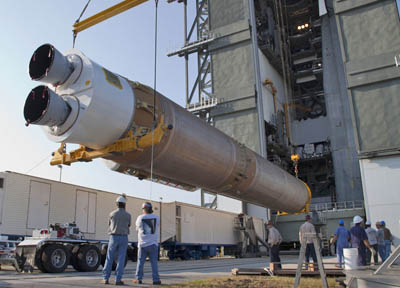
Powered by an RD-180 main engine delivering 860,000 pounds of thrust, the first stage is known as the Common Core Booster. It houses tanks to hold 50,000 gallons of chilled liquid oxygen and 25,000 gallons of RP-1 fuel, a highly refined variety of kerosene, for the RD-180 engine's four-minute burn to reach the upper atmosphere.
Technicians planned to add an interstage adapter before hoisting the Atlas 5's Centaur upper stage atop the booster Monday, completing the build-up of the two-stage rocket.
The launch of NASA's Mars Atmosphere and Volatile Evolution, or MAVEN, mission only requires the most basic version of the Atlas 5 rocket. Called the "401" configuration, the Atlas 5 rocket for MAVEN features no solid rocket boosters, a Centaur stage with a single RL10 engine, and a four-meter payload fairing.
ULA can add strap-on boosters, a second RL10 engine and a larger five-meter nose shroud for payloads requiring the extra capability.
The launch of MAVEN will be the seventh Atlas 5 flight of the year, and the sixth from Cape Canaveral's seaside launch pad. ULA workers are in the final stretch of integrating and testing a Delta 4 rocket and its payload, a U.S. Air Force GPS navigation satellite, at Complex 37B for launch Oct. 23, less than 4 miles from the Atlas 5 rocket's launch pad.
Preparations for MAVEN's launch continue despite the partial shutdown of the federal government. After a two-day pause in the spacecraft's processing last week, NASA granted an exemption to resume work on MAVEN, which is in a time crunch to launch in a narrow window between Nov. 18 and mid-December.
Mars missions can only launch when the planets are properly aligned, and the next opportunity to launch MAVEN after December comes in early 2016.
But thanks to its exemption from the government shutdown, MAVEN is on schedule to launch Nov. 18 in a two-hour launch window opening at 1:28 p.m. EST (1828 GMT).
The $671 million mission will reach Mars in September 2014, entering an elliptical orbit dipping into the outermost layers of the Martian atmosphere to sample its composition and measure its response to stimuli from solar activity.
Scientists hope MAVEN will address uncertainties in how Mars evolved from a planet with a warmer, thicker atmosphere with water into the barren world observed today.
Technicians from Lockheed Martin Corp., MAVEN's prime contractor, will load about 3,600 pounds of hydrazine fuel into the spacecraft's propellant tank Oct. 24. The Atlas 5's clamshell-like payload fairing will encapsulate MAVEN on Nov. 5, and workers plan to transport the Mars orbiter to the Atlas 5 launch pad Nov. 7 to top off the 19-story launcher.
Quelle: ULA
CU-Boulder's MAVEN one month from Mars departure
After nearly a decade of preparation, the countdown is now at one month for MAVEN, one of the most momentous space missions in which the University of Colorado has ever been involved.
The launch window raises Nov. 18 and extends through Dec. 7, although mission principal investigator Bruce Jakosky, of a professor at CU's Laboratory for Atmospheric and Space Physics, said it could depart for Mars as late as Dec. 15 without a significant impact on its activities.
CU boasts a long history in space, with 19 of 20 CU-affiliated astronauts having flown in space, and its scientists having placed dozens of payloads on NASA's 135 shuttle missions. But the $670 million MAVEN -- Mars Atmosphere and Volatile Evolution -- is stirring an added level of excitement in the university's science community and beyond.
"It's got to be in the top three or top five, something like that," said Bill Possel, LASP's science operations center manager for the MAVEN project, "the fact that CU is in charge of the entire mission."
Jakosky, a geological sciences professor, wrote in an email, "MAVEN will be able to tell us about the history of the climate and what caused the changes and it will not tell us whether life actually existed or still might exist on Mars today.
"MAVEN is about understanding the history of the habitability of Mars by microbes. But we will not determine whether it actually is inhabited by microbes."
He said its significance to the university's space legacy stems from "the fact that we could credibly propose a mission like this, provide two science instruments, do the science operations, all take advantage of this long history and the experience that comes with it," he wrote in an email. "MAVEN is certainly the largest program we've ever led, and the most visible."
Scuttled by politics -- but only briefly
MAVEN was temporarily but seriously jeopardized by the federal government shutdown, which began Oct. 1.
The project was shut down -- all operations put into what scientists call a "safe state" -- but not for long. Jakosky learned Oct. 3 that NASA had given MAVEN an emergency exemption, ruling that other functions it can also perform, such as serving as a data relay station for other Mars-based NASA exploration, made it an essential operation.
"There was a lot of nervousness for us," said Guy Beutelschies, program manager for Lockheed Martin Space Systems, which manufactured the spacecraft at its plant in Littleton, and who is now also in Florida preparing for the launch. "This alignment of Earth and Mars, we would have had to wait over two years before they're in position again."
Possel said he spent the roughly 48 hours that MAVEN appeared threatened by government gridlock "shaking in my boots."
"But I was thrilled to see that we were restarted (Oct. 3)," he said. "At this point, we are looking great for that Nov. 18 launch date."
Possel will be on hand for the launch and should have plenty of company. CU has organized a series of events for the roughly 300 alumni, faculty, staff and others who have registered for university-sponsored activities in Florida.
Those will start with a reception and talk by Jakosky the evening of Nov. 16, followed by a bus tour at the Kennedy Space Center on Nov. 17. Launch morning will kick off with a lecture called "CU in Space," presented by CU astrophysics professor Erika Ellington, before buses leave for Launch Complex 41 for a liftoff slated between 1:29 and 3:29 p.m.
But Buffs-centric space buffs won't have to be in Florida to share in the excitement because a MAVEN launch party is set for the University Memorial Center from 11 a.m. to 2 p.m., with activities for visiting K-12 students as well as live-streaming from NASA of MAVEN's departure.
MAVEN headed to Martian orbit
It will take about 10 months for MAVEN to reach the Martian orbit, where it will be gathering data for at least one year. Its stay there could last longer.
"Our primary mission is one Earth year," Jakosky said. "We chose that duration because, in a year of observations, we can collect the data that would allow us to answer the science questions we originally posed.
"After that year is over, we hope to continue to be able to collect data. We can use a longer period of data collection to answer a set of augmented science questions."
Jakosky sees a "very high science value" in the mission being extended, but NASA has not yet committed to doing so.
Collecting the data will be three separate instrument packages. They are the Neutral Gas and Ion Mass Spectrometer, which can measure different isotope rations; the Imaging Ultra Violet Spectrograph, built in Boulder by LASP; and the Particles and Fields package, which contains six different instruments.
One of the six instruments in the Particles and Fields package is known as the Langmuir Probe and Waves, tasked with measuring electron density and temperature, electric fields and extreme ultraviolet observations from the sun.
LASP's Laila Andersson is co-investigator on the Langmuir instrument. She points out that the only previous data on electron temperature in the Martian atmosphere came from the Viking 1 and 2 landings in 1976.
"Since those two landers, we haven't measured the electron temperature in the atmosphere, and all the atmospheric modeling from Mars is based on those measurements," Andersson said. "It is very tricky to model the electron temperatures; therefore getting more observations is important."
Anderrson is one of roughly 150 LASP personnel who have worked on the project -- and will be among the 55 who will be part of the contingent at the Kennedy Space Center for the launch.
CU has many MAVEN partners. They include NASA's Goddard Space Flight Center, which manages the project and provided two of the science instruments for the mission. The University of California at Berkeley Space Sciences Laboratory provided science instruments for the mission. NASA's Jet Propulsion Laboratory, at Pasadena, Calif., will provide navigation support, and Centennial-based United Launch Alliance built the Atlas V rocket MAVEN will ride on.
Lockheed's Beutelschies, a CU graduate himself and former member of LASP, said Lockheed has been involved on some level with every NASA Mars mission back to the Viking project.
"But this is the first mission where the university has been our principal investigator, and so getting to work with CU, that makes it special," Beutelschies said.
Asked if there would be any black and gold on board, he joked: "Maybe hidden here and there. Just don't tell anybody."
Quelle: Capella University

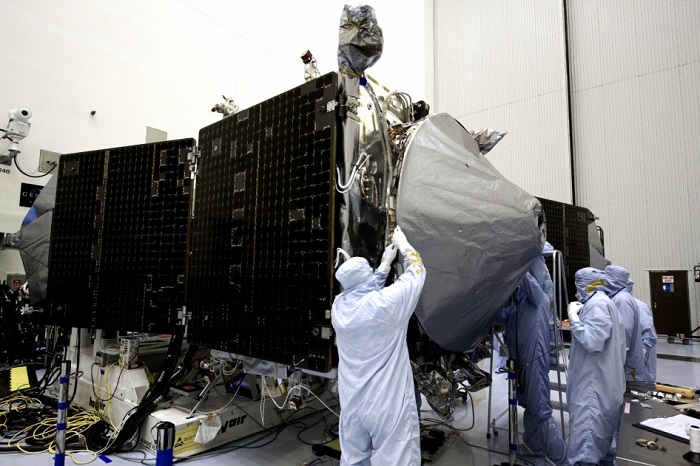
Inside the Payload Hazardous Servicing Facility at NASA's Kennedy Space Center in Florida, engineers and technicians install a radome over the antenna for the Mars Atmosphere and Volatile Evolution, or MAVEN, spacecraft. The radome is a coated kapton cover providing thermal protection for the high gain antenna while not interfering with radio frequency transmissions from the spacecraft.
.

Inside the Payload Hazardous Servicing Facility at NASA's Kennedy Space Center in Florida, engineers and technicians deploy the Solar Wind Electron Analyzer boom on the Mars Atmosphere and Volatile Evolution, or MAVEN, spacecraft. The analyzer will measure the solar wind and electrons in the ionosphere of the Red Planet.
Quelle: NASA
.
Update: 21.10.2013
.


Quelle: ULA
-
Update: 28.10.2013
.
Quelle: NASA
.
Update: 29.10.2013
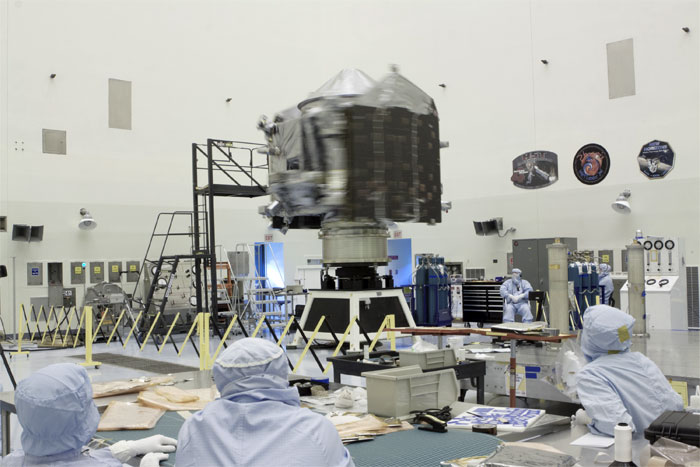
.
Update: 6.11.2013
.

.

.

.

.

.
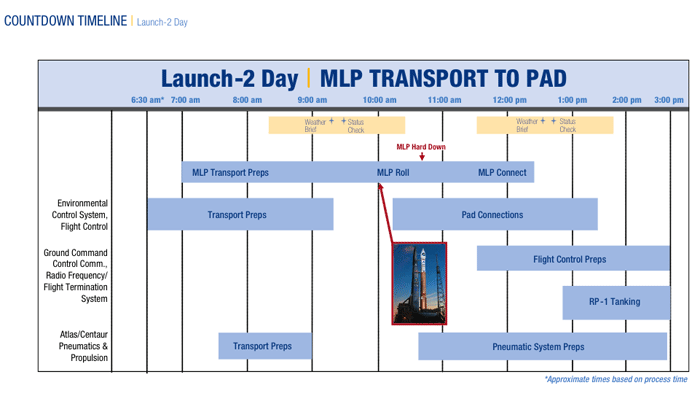
.
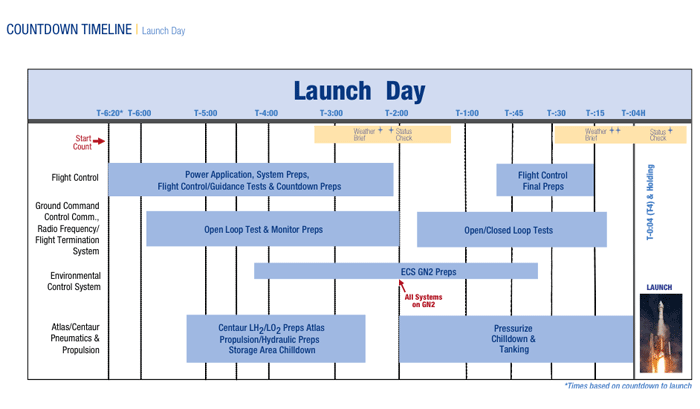
.

Quelle: ulalaunch
NASA Mars orbiter hoisted atop Atlas V rocket at Cape

.
